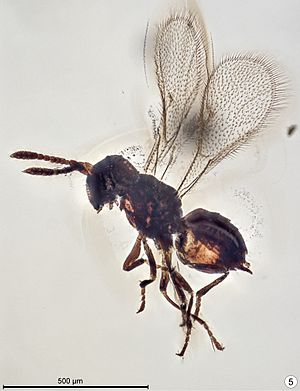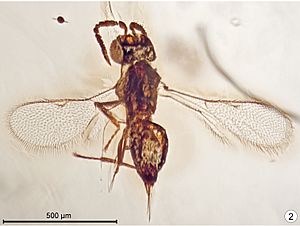Rotoitidae facts for kids
Quick facts for kids Rotoitidae |
|
|---|---|
 |
|
| Baeomorpha liorum Male | |
 |
|
| Baeomorpha liorum Female | |
| Scientific classification |
|
| Kingdom: | Animalia |
| Phylum: | Arthropoda |
| Class: | Insecta |
| Order: | Hymenoptera |
| Superfamily: | Chalcidoidea |
| Family: | Rotoitidae Bouček & Noyes, 1987 |
| Genera and species | |
|
|
The Rotoitidae are a very small family of rare wasps. These wasps are known as relictual parasitic wasps. This means they are an ancient group, like living fossils. They belong to a larger group called Chalcidoidea.
Most Rotoitidae species are only known from fossils. Scientists have found 14 extinct species in two different groups, called genera. These are Baeomorpha and Taimyromorpha.
Only two living species of Rotoitidae are known today. Each of these lives in its own genus. One species is found in New Zealand, and the other in Chile. We do not know much about how these living wasps live their lives.
Contents
What Are Rotoitidae Wasps?
Rotoitidae wasps are a unique family of tiny insects. They are part of the Chalcidoidea superfamily. This group includes many different kinds of small wasps. Rotoitidae are special because they are very old. They are thought to be one of the earliest branches on the chalcidoid family tree. This means they are closely related to the first chalcidoid wasps that ever lived.
Ancient Wasps: Fossils and History
Most of what we know about Rotoitidae comes from fossils. These fossils are often found preserved in amber. Amber is fossilized tree resin. It can trap insects and keep them safe for millions of years.
Scientists have found many fossil Rotoitidae species. Most of these fossils come from the Late Cretaceous period. This was a time when dinosaurs still roamed the Earth.
- Some fossils are from Taimyr amber in Russia. These are about 85 million years old.
- Other fossils are from Canadian amber. These are also from the Late Cretaceous period.
- One special species, Baeomorpha liorum, was found in Burmese amber. This fossil is even older, from about 95 to 100 million years ago.
These fossils help us understand how these wasps have changed over millions of years.
Living Rotoitidae: Where They Are Now
Today, only two species of Rotoitidae are known to be alive. They are very rare.
- One species lives in New Zealand.
- The other species, called Chiloe micropteron, lives in Chile.
Not much is known about the daily lives of these living wasps. Scientists are still studying them to learn more.
Unique Features of Chiloe micropteron
The female Chiloe micropteron wasps have a very interesting feature. Their wings are extremely small. They are reduced to tiny bristles. This means they cannot fly like most other wasps. This adaptation might help them in their specific environment.
See also
 In Spanish: Rotoitidae para niños
In Spanish: Rotoitidae para niños

